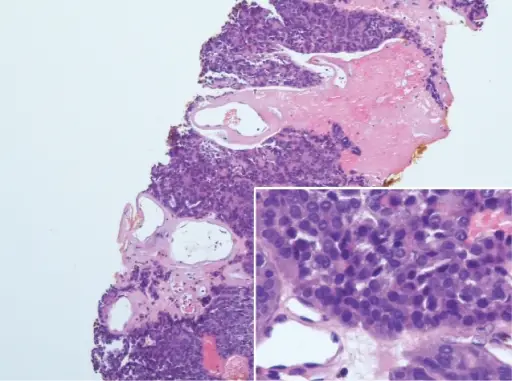Adenocarcinoma of the larynx is rarely seen and presumably arising from mucous glands.
What is the Pathology of Adenocarcinoma of the Larynx?
The pathology of adenocarcinoma of the larynx is:
-Etiology: The cause of adenocarcinoma of the larynx is, HPV, nicotine uses, and alcohol consumption.
-Genes involved: None.
-Pathogenesis: The sequence of events that lead to adenocarcinoma of the larynx, transpires at the histologic and molecular level. Molecular phases tangled in tumorigenesis not fully elucidated. Histologic advancement arises from typical laryngeal mucosa to dysplastic mucosa, carcinoma in situ culminating to invasive carcinoma.
-Histology: The histology associated with adenocarcinoma of the larynx shows squamous cell carcinomas of the larynx follow the growth pattern of all squamous cell carcinomas.
How does Adenocarcinoma of the Larynx Present?
Patients with adenocarcinoma of the larynx typically have a male-to-female ratio of 4:1. present at age range of 50 to 70 years. The symptoms, features, and clinical findings associated with adenocarcinoma of the larynx include: Dysphonia/aphonia, cachexia dysphagia, pain, dyspnea, halitosis, aspiration, expectoration of tissue, blood-tinged sputum, neck mass, fatigue, otalgia, weight loss, and weakness
How is Adenocarcinoma of the Larynx Diagnosed?
Adenocarcinoma of the larynx is diagnosed through: Laboratory studies; Arterial blood gas analysis, platelet count, thyroid function test. Imaging studies; CT scan, plain chest radiography. PET-CT scan (Positron emission tomography-computerized tomography) may also be useful.
How is Adenocarcinoma of the Larynx Treated?
Adenocarcinoma of the larynx is treated often by radical surgery, adjuvant radiotherapy, and chemotherapy. There is no harmony regarding its treatment and augmented recurrence.
What is the Prognosis of Adenocarcinoma of the Larynx?
The prognosis of adenocarcinoma of the larynx is poor as there is no harmony regarding its treatment.



